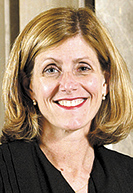Subscriber Benefit
As a subscriber you can listen to articles at work, in the car, or while you work out. Subscribe Now
Just a few months after Judge Matthew Brookman was sworn in as the U.S. District Court for the Southern District of Indiana’s newest judge, Judge Jane Magnus-Stinson, of the same court, announced she would be assuming senior status in July 2024 and taking on a reduced caseload.
That means the Biden administration, in conjunction with Indiana Republican Sens. Todd Young and Mike Braun, will need to fill another federal judicial vacancy in Indiana, in addition to two openings on the U.S. District Court for the Northern District of Indiana and a seat on the 7th Circuit Court of Appeals, where Indiana Northern District Magistrate Judge Joshua Kolar hopes to win confirmation from the U.S. Senate.
Carl Tobias, a University of Richmond School of Law professor, said he thinks the federal judicial nomination process has slowed overall, even with judges like Brookman getting confirmed this year.
“Biden, just like Trump, went for the low-hanging fruit with vacancies that are easier to fill,” Tobias said, adding that the vacancies that were filled generally came from states with two Democratic senators.
Now, Tobias said, a number of the remaining federal judicial vacancies are in states that have two Republican senators, including Indiana. That means the Biden administration will have to be willing to negotiate with those Republicans on judicial nominees.
Tobias noted that in Indiana, Young has been amenable to working with the White House on filling federal judicial vacancies.
For example, both Young and Braun cooperated on Judge Doris Pryor’s confirmation to the 7th Circuit in 2022, with both senators and other Republicans, including Senate Minority Leader Mitch McConnell, R-Kentucky, voting for the Indiana judge.

But Tobias also noted that Senior Judge Theresa Springmann’s seat on the bench in the Northern District has been vacant for more than two years now.
According to the U.S. Courts website, Springmann assumed senior status on Jan. 23, 2021, while Senior Judge Jon DeGuilio assumed senior status July 17, 2023. President Joe Biden has not publicly announced nominees to succeeded Springmann or DeGuilio, nor has he announced a nominee to succeed Magnus-Stinson on the Southern District bench.
The 7th Circuit vacancy Kolar would fill was created by the death in June 2022 of Judge Michael Kanne. Kolar wasn’t nominated until July 27 of this year.
The oldest federal judicial vacancy still pending dates back to 2017, according to the U.S. Courts: Judge Beverly Reid O’Connell of the Central District of California died Oct. 8, 2017 — under the Trump administration — and her would-be successor, Magistrate Judge Kenly Kiya Kato, wasn’t nominated until Jan. 3, 2023, under Biden.
“You like to not see those go on too long,” Tobias said.
Southern District caseloads remain high
Confirmed to the federal bench in 2010 after being nominated by former President Barack Obama, Magnus-Stinson, who will be 66 next year, will take senior status soon after she becomes eligible to do so — a decision Tobias said is common among federal judges.
“It’s widespread. It’s also generous because you get to keep the experience of that judge, 20, 30 years. And you get a lighter workload,” he said. He noted that when a federal judge assumes senior status, the court gets to bring in fresh blood and add another judge to share the docket.
Likewise, Magnus-Stinson told Indiana Lawyer she is taking senior status in part to bring another full-time judge into the Southern District and help ease the district’s weighted caseload numbers with that judicial addition, plus her continued service on the bench.
 Based on United States District Courts National Judicial Caseload Profile numbers for the 12-month period ending Dec. 31, 2022, the Indiana Southern District’s 645 weighted filings per judgeship placed the court first within the 7th Circuit and seventh nationally in terms of caseloads.
Based on United States District Courts National Judicial Caseload Profile numbers for the 12-month period ending Dec. 31, 2022, the Indiana Southern District’s 645 weighted filings per judgeship placed the court first within the 7th Circuit and seventh nationally in terms of caseloads.
Magnus-Stinson recalled the time before Southern District Judges James Sweeney and James Patrick Hanlon were confirmed in 2018, describing the caseload then as brutal.
A judicial emergency had been declared in the Indiana Southern District after Judge Sarah Evans Barker took senior status in 2014. Her successor, Sweeney, was not confirmed for another four years.
As a stopgap measure, the Indiana Southern District began a “borrowing and lending” partnership in which two judges from the Eastern District of Wisconsin entered into the regular rotation of case assignments in the Southern District’s Indianapolis Division.
“It was a very difficult time,” said Magnus-Stinson, who was chief judge at the time.
She added that with Judge Richard Young’s assuming senior status in 2022 and Brookman’s elevation to the Southern District bench earlier this year, the caseloads have gotten better.
“We feel that relief,” she said.
But even with Brookman’s confirmation, Magnus-Stinson said the Southern District still has higher weighted caseloads than other judges in the circuit.
She said she’s cautiously hopeful that her position will be filled in a timely manner. She credited Indiana’s senators for their work in trying to fill vacancies.
“I know that the senators are mindful of our workload,” she said.
The politics of confirmation
A presidential election year makes a difference in how quickly federal judicial vacancies are filled.
Going back to President George W. Bush, Tobias said the nomination and confirmation process for federal judges has become more partisan, with less cooperation with the White House, regardless of what party the president belongs to.
Tobias said the dynamic he sees now is that whoever has the White House just pushes through their nominees.
“I don’t think it should be hard to fill those seats,” he said.
As for Indiana, Tobias said he hopes the White House will come forward with nominations for the Northern District vacancies soon and fill them in 2024.
John Collins, an associate professor at George Washington University Law School, said the Biden administration has fallen slightly behind the Trump administration’s pace in terms of filling federal judicial vacancies. He also said he thinks the filling of district court vacancies has slowed in Republican states like Indiana.
There have probably been discussions already between senators and the White House on who is going to fill the district court seats in the Northern District of Indiana, Collins opined.
“I think that bodes well to put together a package on the three seats in Indiana,” he said.
Still, Collins said he doesn’t know exactly when any federal judicial vacancies in Indiana might be filled. He noted Indiana is near the top of the curve for red states in terms of filling judicial vacancies.

The 2024 elections will have an impact on the number of judicial vacancies that are filled in the summer leading up to the election, Collins added. The professor said U.S. senators that are up for reelection will be ready to get out of Washington and onto the campaign trail as quickly as they can.
“If you have folks out campaigning, it makes it hard to get a steady flow of nominees confirmed,” he said. “I think it will be challenging to keep a steady pace the closer we get to the election.”
Another reason the Biden White House is incentivized to work with senators like Young and Braun, Collins said, is that having two Republican senators on board will ultimately increase the confirmation margin for individual federal judicial nominees.
Tobias opined that Young would support for Kolar and work with Senate Judiciary Committee Chairman Sen. Dick Durbin, D-Illinois, to push for confirmation. Indeed, Young enthusiastically introduced Kolar to the Senate Judiciary Committee at the magistrate’s first nomination hearing earlier this month.
Tobias said he’s cautiously optimistic Kolar will get a confirmation vote from the Senate in October or November.•
Please enable JavaScript to view this content.
